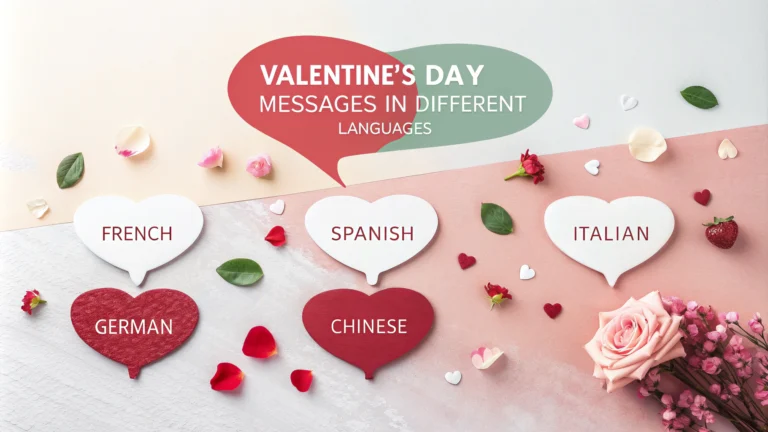Valentine’s Day expressions of love and romance span across cultures, languages, and traditions worldwide.
Common Valentine’s Day Phrases in European Languages
- French: “Je t’aime” (I love you)
- Spanish: “Te amo” or “Te quiero” (I love you)
- Italian: “Ti amo” (I love you)
- German: “Ich liebe dich” (I love you)
- Portuguese: “Eu te amo” (I love you)
Asian Love Expressions
- Japanese: “愛してる” (Aishiteru – I love you)
- Korean: “사랑해요” (Saranghaeyo – I love you)
- Mandarin Chinese: “我爱你” (Wǒ ài nǐ – I love you)
- Thai: “ฉันรักคุณ” (Chan rak khun – I love you)
Sweet Valentine’s Day Greetings
| Language | Greeting | Translation |
|---|---|---|
| Russian | я тебя люблю | Ya tebya lyublyu (I love you) |
| Arabic | أحبك | Uhibbuka/Uhibbuki (I love you) |
| Hindi | मैं तुमसे प्यार करता/करती हूं | Main tumse pyaar karta/karti hoon (I love you) |
Tips for Using Foreign Language Love Messages
- Check pronunciation using language learning apps or native speakers
- Write the message in both original script and phonetic spelling
- Include translation to show thoughtfulness
- Consider cultural context and appropriateness
Writing Your Own Valentine’s Message
Personalize your message by combining phrases from different languages that hold special meaning for you and your partner.
Quick Tips for Perfect Delivery
- Practice pronunciation beforehand
- Add personal touches like memories or inside jokes
- Consider writing the message in beautiful calligraphy
- Record yourself saying the phrases if sending digitally
For accurate translations and pronunciations, check reliable language resources like Forvo or consult native speakers.
Remember that some cultures may celebrate love differently or on different dates than traditional Valentine’s Day.
Additional Resources
- Duolingo – For basic language learning
- Tandem – For practicing with native speakers
- Google Translate – For quick translations
Cultural Significance of Love Expressions
Love expressions carry deep cultural meanings beyond literal translations. Understanding these nuances helps deliver more meaningful Valentine’s messages across cultures.
Cultural Considerations
- Some cultures prefer indirect expressions of love
- Certain phrases may be reserved for serious relationships
- Physical gestures might accompany verbal expressions
- Traditional customs may influence timing and delivery
Modern Digital Love Expressions
- Love-themed emojis across platforms
- Digital Valentine’s cards with audio messages
- Social media love declarations
- Video calls with synchronized expressions
Conclusion
Expressing love in multiple languages adds depth and thoughtfulness to Valentine’s Day messages. Whether traditional or modern, written or spoken, these expressions bridge cultural gaps and create meaningful connections.
Final Reminders
- Authenticity matters more than perfect pronunciation
- Research cultural context for appropriate usage
- Combine traditional phrases with personal meanings
- Document special moments in multiple languages
Share your multilingual love story and continue exploring new ways to express affection across cultural boundaries.
FAQs
- What are some romantic ways to say “I love you” in different languages?
French: “Je t’aime”, Italian: “Ti amo”, Spanish: “Te amo”, German: “Ich liebe dich”, Japanese: “愛してる” (Aishiteru), Mandarin: “我爱你” (Wǒ ài nǐ) - How do different cultures celebrate Valentine’s Day?
In Japan, women give chocolates on February 14th while men reciprocate on March 14th (White Day). In South Korea, couples celebrate on the 14th of every month with different themes. In Brazil, they celebrate “Dia dos Namorados” on June 12th. - What are traditional Valentine’s Day greetings in Spanish-speaking countries?
“Feliz día de San Valentín”, “Eres el amor de mi vida” (You’re the love of my life), “Te quiero mucho” (I love you very much), “Mi corazón es tuyo” (My heart is yours) - Which Valentine’s Day messages are appropriate for formal or business settings?
“Happy Valentine’s Day”, “Wishing you a wonderful Valentine’s Day”, “Have a great celebration” – keep messages simple and professional without romantic connotations - What are some universal Valentine’s Day symbols that work across cultures?
Hearts (❤️), roses, cupids, doves, and the color red are universally recognized Valentine’s symbols that transcend language barriers - How can I write Valentine’s messages for different relationships?
For friends use “Happy Valentine’s Day”, for family members “Lots of love”, for romantic partners use more intimate expressions like “Je t’aime” or “Ti amo” - What are some traditional Chinese Valentine’s Day expressions?
“我爱你” (Wǒ ài nǐ – I love you), “情人节快乐” (Qíng rén jié kuài lè – Happy Valentine’s Day), “永远爱你” (Yǒng yuǎn ài nǐ – Love you forever) - How do you say “Be My Valentine” in different European languages?
French: “Sois mon Valentin”, Italian: “Sii il mio Valentino”, German: “Sei mein Valentinsschatz”, Spanish: “Sé mi Valentín” - What are some Arabic Valentine’s Day expressions?
“أحبك” (Uhibbuka/Uhibbuki – I love you), “عيد حب سعيد” (Eid hob said – Happy Valentine’s Day), “كل عام وانت حبيبي” (Kol am wa enta habibi – Every year and you are my love) - Which Valentine’s Day messages are suitable for social media?
Short, sweet messages with emojis work best: “Happy ❤️ Day”, multilingual messages like “Love/Amor/Amour”, or simple universal expressions like “XOXO” or “♥️”







